If you are wondering how to get your baby to take a pacifier, you’re in good company! It is pretty standard for a baby to refuse the pacifier.
Let’s go through 12 simple tricks to help your baby accept the pacifier in no time!
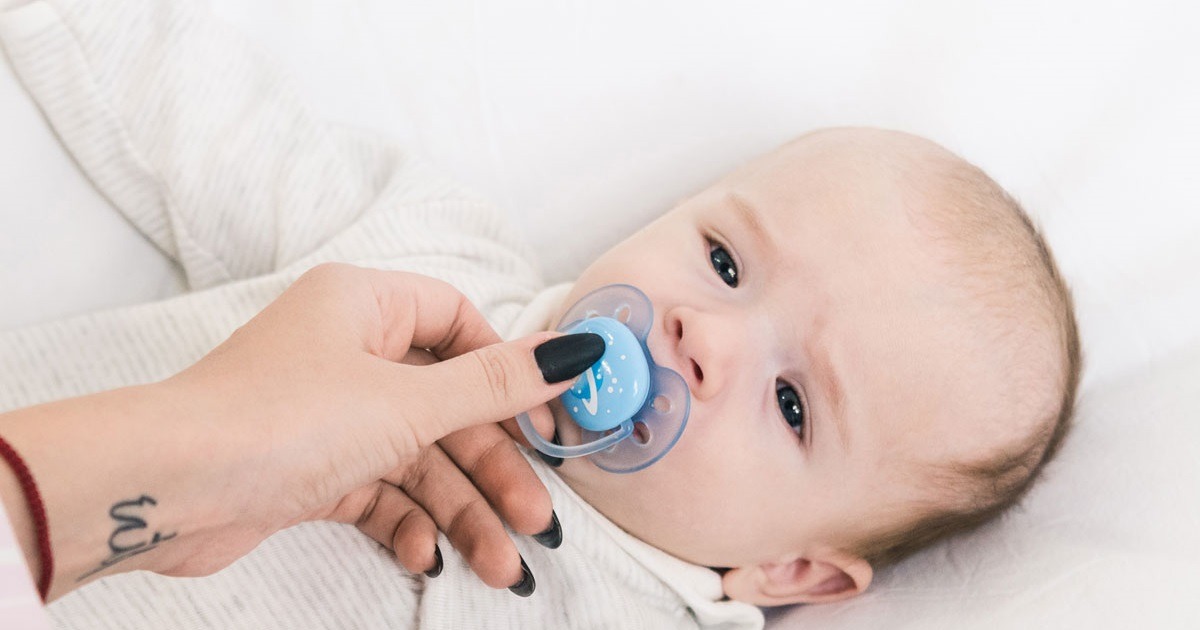
First, you desperately want them to accept the pacifier, and then three years later, you, just as desperately, want them to stop using it… Parenthood in a nutshell, LOL!
Before diving into how to get your baby to take the pacifier, let’s look at the possible risks and benefits of pacifier usage.
Risks & Benefits of Pacifier Use
Drawbacks of Pacifier Use
Maybe you’ve also heard that a child using a baby pacifier will get ugly teeth and have trouble learning to talk. (So now we feel both desperate and as bad parents at the same time…)
Well, studies show that these risks of pacifier use are overstated.
Risks that DO exist are that the pacifier can cause nipple confusion and interfere with the establishment of breastfeeding – if the pacifier is introduced too early, AND that the teeth can be affected if older children use the pacifier.
Another risk confirmed in more than one research study is a link between pacifier use and ear infections. At least two studies have found an increased frequency of ear infections in children who use pacifiers and a reduced frequency when pacifier use was limited (i.e., limited, not stopped). There are several reasons for this link. First, pacifier use can cause negative pressure in the child’s middle ear. This pressure can pull bacteria from the back of the throat into the middle ear, increasing the risk of infection. Secondly, the pacifier suckling may reduce the saliva in the mouth – contributing to less effective clearance of bacteria from the throat. Finally, pacifiers can easily be contaminated, introducing more bacteria or viruses than necessary to the baby.
All these risks increase with increased usage, so it is recommended to limit pacifier use to the first months of living when the suckling reflex is really strong and/or only use the pacifier for soothing or falling asleep rather than all through the day as a habit.
So, the recommendation is to wait at least a month before introducing the pacifier to ensure that successful breastfeeding has been established (if you choose to breastfeed) and wean your child from the pacifier at around two years of age. The American Academy of Pediatrics goes as far as to recommend starting the weaning process at about six months of age. However, they also conclude that pacifiers’ most damaging effects materialize after two or even four years of age.
Due to the risk of dental problems, the American Academy of Pediatric Dentistry recommends weaning the toddler from the pacifier at two years of age.
It is also important to remember that pacifiers can be a choking hazard if broken. Pulling the nipple and checking for cracks are essential parts of safe pacifier use.
Possible Benefits of A Pacifier
There are clear benefits of using a pacifier when babies are young, at least if used in a safe and hygienic way.
The most important benefit is that it seems to reduce the risk of Sudden Infant Death Syndrome (SIDS). (Find a research reference here.) Due to the reduced risk of SIDS (of some 50-90% according to some studies), the American Academy of Pediatrics recommends putting a pacifier in the baby’s mouth for falling asleep up to 6 months of age. It is unclear why pacifiers reduce the risk of SIDS, but cleared airways, preventing them from rolling over to belly sleeping, and improved heart rate are all raised as possible reasons. The risk reduction has been seen both for full-term and premature babies.
Two other benefits are that Mom doesn’t have to be the baby’s human pacifier and that it is easier to teach the baby to fall asleep on its own if he uses a dummy. Note, though, that research does not support that the baby’s sleep overall is improved by using a pacifier. Young babies who can’t yet put the pacifier back into their mouth may wake up more frequently due to losing the pacifier at night. Add to that their short sleep cycles, and you risk frequent wake-ups where you have to go up and put the pacifier back into your baby’s mouth. To avoid this, you can try to pull out the pacifier once the baby has fallen asleep so they learn to sleep without something in their mouth.
Other benefits are pain relief in newborns and infants and oral training for premature babies.
A pacifier may also soothe a fussy baby and calm a crying baby.
Last, as many babies suck on something anyway, a pacifier might be a good alternative because they can be thrown away. It might be much harder to help the baby (or toddler when the day comes) break the thumb-sucking habit.
Young babies have a strong urge to suckle, especially during their first four months. After these first months, this non-nutritive sucking need slowly decreases.
So, easy decision, go ahead and buy one. Put it in the baby’s mouth, and… he spits it out?! Again and again..? Yes, many babies do refuse the pacifier!
Look below for a few tips on how to make your baby take the pacifier.
If you want to learn more about safe dummy usage (how to wash it, when to throw it away, etc.), you’ll find tips on using baby pacifiers safely here.
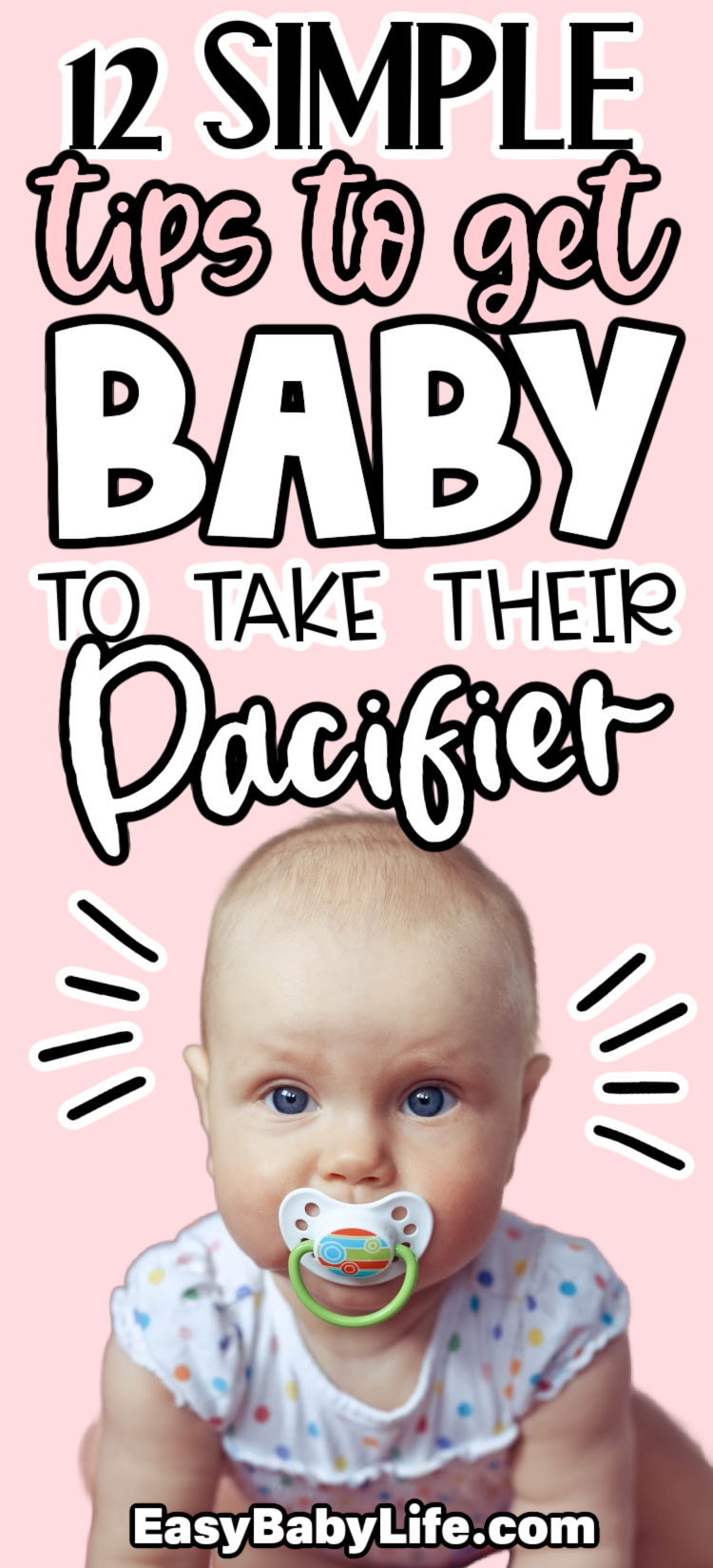
12 Tips on How to Get Your Baby To Take A Pacifier
1. Wait a few weeks
Don’t introduce a pacifier until breastfeeding has started to work if you plan to breastfeed. Sucking on a pacifier and breastfeeding are two different techniques, so the baby can get confused if you start too early with the pacifier.
The general recommendation is to wait a month after birth before introducing a pacifier to your newborn baby if you plan to breastfeed. I did that with my first baby.
With my second baby, the breastfeeding went so well that I tried to introduce a dummy the first time when my newborn was less than two weeks old. It didn’t work at all! It didn’t interfere with breastfeeding or the milk supply; he just didn’t want anything to do with a pacifier.
Actually, none of my babies were interested in a pacifier until they were 2.5 months old.
So don’t give up!
2. Be patient
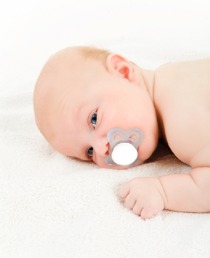 Even when the baby is old enough for a pacifier according to the recommendation, there is no guarantee that the baby is ready. It may work immediately, after some time, or never. All kids are different. Hence, there is no clear “best time” to introduce the pacifier, although you can probably argue that after four months of age, as the sucking reflex gets weaker, the benefits of introducing a pacifier probably decrease.
Even when the baby is old enough for a pacifier according to the recommendation, there is no guarantee that the baby is ready. It may work immediately, after some time, or never. All kids are different. Hence, there is no clear “best time” to introduce the pacifier, although you can probably argue that after four months of age, as the sucking reflex gets weaker, the benefits of introducing a pacifier probably decrease.
In my experience, patience is key to getting your baby to take the pacifier. Try every other day or so. Timing is also crucial. Do not offer the pacifier when your baby is crying hysterically, is overtired, or starving.
You are much more likely to have luck with the introduction if you go slowly and think of the pacifier as a toy at first, not as something to soothe your baby immediately.
As I mentioned, in my experience, it may also work a bit better once your baby is not an absolute newborn anymore.
3. Try when your baby is happy
It is very tempting to try the pacifier in some desperate situation when your baby is crying at the top of their lungs.
Forget it!
No one, baby or adult, appreciates having an unknown object shoved into their mouth when upset. You can be sure your baby will refuse the pacifier in such a situation!
Let your baby get used to the pacifier when they are a little tired, showing signs of wanting to suckle, or even just as a fun interaction and play with you! But not when they are starving or too tired!
4. Tap it or shake it
Some parents notice that their baby immediately starts to suck on the pacifier if they put it in his mouth and then tap it lightly with a fingernail.
Another trick is to shake the pacifier a little bit inside the baby’s mouth.
Both these tricks trigger the baby’s instinct and natural behavior to suckle.
Scratch or tickle your baby’s cheek
Another trick that may sound strange is to softly “scratch” your baby’s cheek while putting in the binky. Just as with tapping the pacifier, this may trigger the baby’s sucking reflex.
5. Make it tasty
Another trick is to dip the dummy in breast milk or formula. This way, the pacifier will taste good at first and possibly make your baby at least accept keeping it in the mouth for a few seconds – it may be enough to associate the dummy with a good feeling.
6. Make it body temperature
Since your own nipple and bottle nipples will be relatively warm, it may be a good idea to warm up the pacifier nipple a bit before offering it to your baby. Do not suck on it, though, as you may risk contaminating it. Instead, use clean, warm water or possibly your clean hand.
7. Put it in and then pull it out
If your baby does accept to have the pacifier in their mouth, you can try to pull it out a little bit, slowly. This may trigger the baby to start sucking! I am not sure why this works, but the baby seems to feel that they are losing this thing in their mouth and instinctively want to keep it.
8. Try right after feeding
Some babies are more prone to taking the pacifier when they have just been fed. While still in your arms, gently swap the breast or bottle for the pacifier. You might have to do the swapping a couple of times before your baby accepts it. Just make sure not to turn the situation into a power struggle. This is just ONE trick to try; if it doesn’t work, try something else!
9. Try when your content baby is just about to drift off to sleep
If your baby is content, nap time can be the perfect time to try offering the binky. Warm the nipple up a little bit, dip it in breast milk or infant formula, and slowly and gently insert it into your baby’s mouth. If he or she is already almost asleep, chances are that they will accept the pacifier and start sucking it. The additional benefit then is a clear reduction of the risk of SIDS – even if your baby loses the pacifier while asleep and you do not put it back-
10. Let someone else try
It is more effective for some babies to let someone who usually does not feed the baby try. If your baby expects milk and gets angry when you offer a binky instead, try letting someone else your baby feels safe with introduce the pacifier.
11. Try different kinds
So, which is the best pacifier? Well, the answer is that the best pacifier is the one that the baby likes!
You can offer your baby all sorts of different shapes, different sizes, materials, and brands. They might not like the first one you choose.
All my children have preferred latex or natural rubber pacifiers rather than silicone. I don’t know why, but maybe it is because they are slightly softer. Bottle-fed babies may prefer a pacifier similar to their favorite bottle nipple. Some babies like orthodontic design, while others prefer a traditional round nipple. (An orthodontic pacifier is designed to mimic the shape the mother’s nipple forms while the infant is breastfeeding.)
There are really no baby pacifiers that are harmful to your baby’s teeth today (if used within limits). Just pick and choose the style your baby likes.
12. Keep calm
Make sure you don’t transfer any stress or frustration to your baby even if you really, really want them to take the pacifier, and they refuse! Your baby will sense your frustration, become more anxious, and even more challenging to convince. Take a deep breath, release any tension, put on a smile, and try to help your baby in a positive way.
Also, realize that some babies never take a pacifier, no matter how much you try in all the best ways. It is a matter of preference, and they have all the right to refuse.
Takeaway
To conclude, there are both drawbacks and possible benefits of pacifiers. Due to the significant reduction of the risk of SIDS, using a pacifier is recommended at least between the ages of 1 and six months.
However, babies may refuse the pacifier when you try to get them to take it. Instead of turning the situation into a power struggle, make sure to limit your own frustration, take a deep breath, and start trying these different tips and tricks to make your baby take the pacifier.
Good luck!
Do you have any additional tips on what worked and what did not? Leave a comment and help a fellow mom! :-)
Read Next
- Baby Pacifiers: Tips For Safe And Hygienic Usage
- How To Break Pacifier Dependence For Baby
- Sudden Infant Death Syndrome (SIDS): How to Reduce the Risk
Research References

Paula Dennholt founded Easy Baby Life in 2006 and has been a passionate parenting and pregnancy writer since then. Her parenting approach and writing are based on studies in cognitive-behavioral models and therapy for children and her experience as a mother and stepmother. Life as a parent has convinced her of how crucial it is to put relationships before rules. She strongly believes in positive parenting and a science-based approach.
Paula cooperates with a team of pediatricians who assist in reviewing and writing articles.

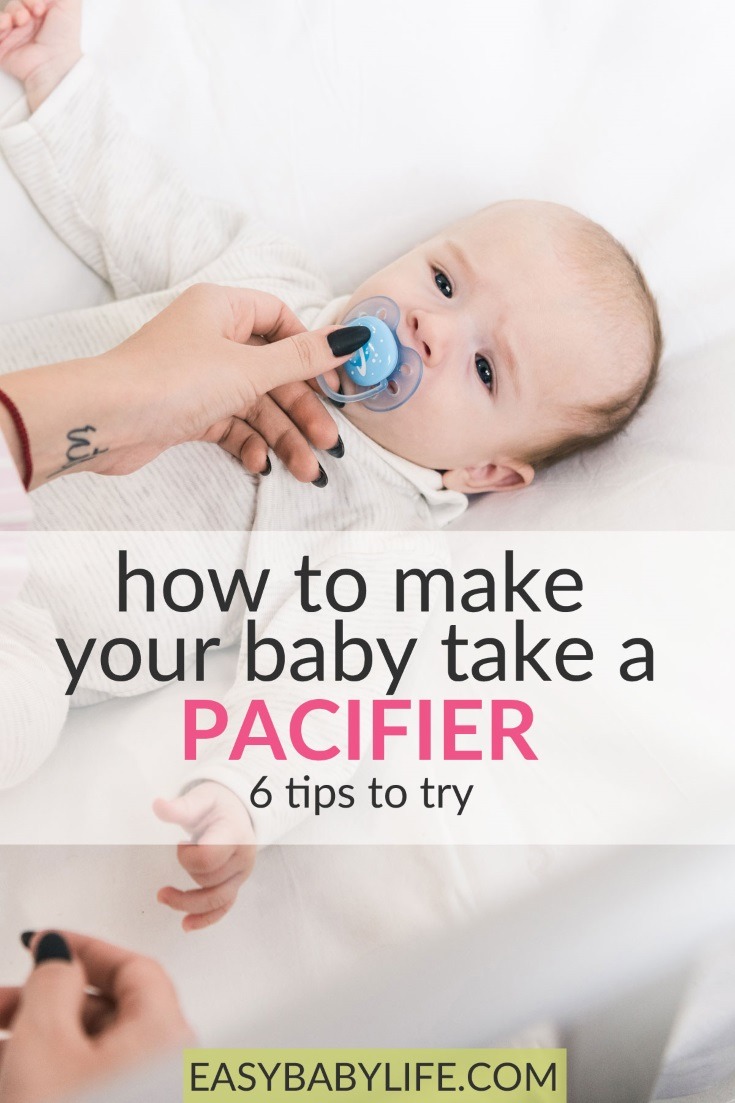
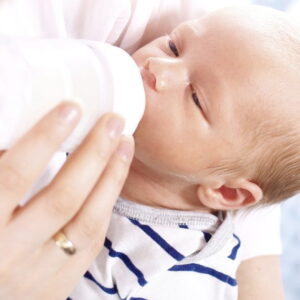
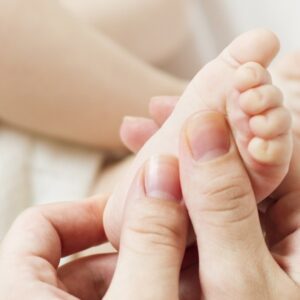


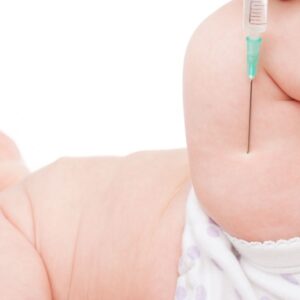
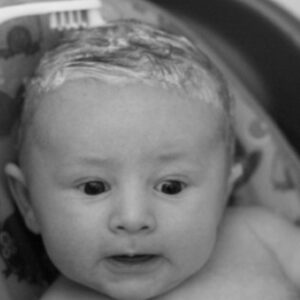
Omg tapping it. Who would have thought! She refused bottles and pacifiers but I am tapping it now and she is taking it!! My nipples and husband (who will now have a way to south her) thank you!!!
That’s great to hear! I can totally relate to the happy nipples. :-)
My baby is four months old and still won’t take it. It’s becoming a problem a she wants to suckle to an hour and a half at bedtime and during nighttime wakings. I’ve tried everything here and on other sites, I’m desperate. She clearly wants to suck but when the milk flows she sputters and arches away.
I tryied everything but it wont work I don’t know what to do.
Hi Milley,
Yes, some babies will never want a pacifier. And for some, it just takes some time. How old is your child?
Hi,
Just try it! I don’t think a particular age is too late. But some babies won’t ever want a pacifier. :-)
Yeah well, I tried it all. Nothing works. He doesn´t even want a bottle of my own milk.
A pacifier just isn’t natural. Think about it: we humans have at least 300,000 years on this planet and evolved from more primitive hominids, none of whom used an artificial item for babies.
Totally true, Roberta! Just as with diapers or strollers. And we don’t have to use any of all these things if we don’t want to! Thanks for reading and commenting!
How about taking the bottle? 😪 I have to return to work in a few weeks and my little one does not want take the bottle
Hi, Yessica!
I know exactly how that is! Will your baby thereby transfer to formula too or only to the bottle? I had huge problems with getting my daughter to take the bottle – only to finally realize that she hated the formula. (She used to be breastfed.) When I switched to another brand, she suddenly couldn’t have enough! :-D But even just the bottle can be difficult. I will add two links for you to two different posts I’ve written on exactly this topic. See if they help with ideas on what to do and please come back either to say it helps or to let me help you with more ideas! Here are the posts:
https://www.easybabylife.com/weaning-a-baby-that-does-not-want-to-stop-breast-feeding.html
https://www.easybabylife.com/bottle-feeding.html
Good luck!
Hello thank you so much for replying. I am breastfeeding ( I pump ) I am open to feed some formula as well. My baby is two months old.
Hi, I think it is great that you will continue breastfeeding as much as possible, since a lot of reaseach seems to point to great benefits of that, especially for the first four months.
Does your daughter use a pacifier? If she does, you can try to find a bottle nipple that is as similar as possible to the shape of her dummy. Also let her try the bottle often when she is not hungry – just for something to suck on. + the tips in two posts.
If you need to introduce formula, and she doesn’t like it, try mixing breast milk and formula in different combinations – first with just a little bit of formula. (But of course, she needs to accept the bottle first. )
Go very slowly if you can with the formula – a lot of breastfed babies get very constipated if you introduce formula as full meals too quickly.
Hello Paula
My daughter does not like the pacifiers but I Will keep insisting to see if she takes it. We got the baby bottle bare air free and she drinks from it but I only get her to drink from it once a day..very true what you said babies sense the stress so I try to be calm and happy. It seems to work.